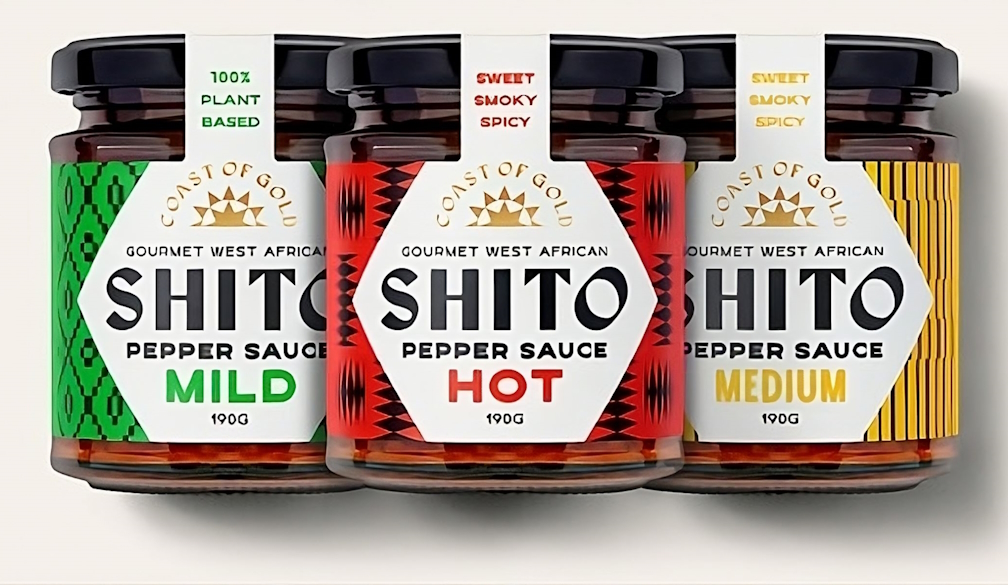Coast of Gold Bursts into Australian Market with Award-Winning Shito Pepper Sauce Range
- Written by The Times

An Australian brand centred on authentic West African flavours is making massive waves in the premium foods and condiments market, with the official launch of the award-winning Coast of Gold Shito Pepper Sauce range.
Arguably the most loved sauce in Ghana, Shito (pronounced Shi-Tow) is a unique blend of hot peppers, herbs, spices and seafood, slow cooked to perfection. Known for its smoky heat and rich flavour profile, it pairs well with a variety of dishes such as rice, grilled meats, vegetables and even snacks.
Boldly bursting into the Australian market with Gold and Silver accolades from the 2024 Melbourne Royal Australian Food Awards, Coast of Gold’s Shito Pepper Sauce is now available in a sweet, smoky and spicy Hot variety (Silver award-winner), Medium heat, and via a 100 per cent plant based Mild (Gold award-winner) recipe.
The range has also received international acclaim via a Gold Star at the 2024 Guild of Fine Food Awards in the United Kingdom.
With all three individual varieties also available in a taster pack and as a value bundle, Shito Pepper Sauce is the hero product of the Coast of Gold brand, which is sold online and delivers nationally and internationally.
Rapidly capturing the attention of specialty food stores since its recent launch, the range is also now sold through more than 70 retailers across New South Wales, the ACT, Victoria and Queensland.
With plans for rapid wider distribution soon across the nation, Coast of Gold was originally founded during the Covid-19 lockdown period in the home kitchen of Ghana-born Sydneysider, Genevieve Muir.
After more than a year of perfecting the recipe via countless test batches made with the input of her family members scattered across the globe – aunties in Ghana, uncles in England, cousins in the Netherlands, the USA, and even Hong Kong – Genevieve says she’s humbled by the recognition to-date and has considerable aspirations for the ongoing growth of Coast of Gold.
“I didn’t set out to become a manufacturer, let alone an award-winner. Coast of Gold is essentially my labour of love. I’m truly humbled by the prestigious recognition to-date and just how much Australians are enjoying the sauce. We’re receiving more orders sooner than I’d ever dreamed possible and I’m very excited for the future of Coast of Gold.
“For me, Shito is more than just a sauce; it’s a cultural experience. We’ve crafted this sauce using traditional methods and premium-quality, ethically sourced ingredients to capture the essence of West African cuisine.
“It certainly took significant time to create the final recipe. Many of my family members contributed with opinions like ‘too much ginger!’ ‘Not enough ginger!’ because although very versatile, Shito is basically part of the deep-rooted culinary heritage of West Africa.
“I’m so pleased to have finally landed on the right recipe for the Australian market and I am so proud of the product. My first proper venture into the Australian condiments market hasn’t been without its challenges and plenty of hard work but it’s also proof of the power of real passion when establishing a food brand,” says Gen.
In addition to its award-winning Shito Pepper Sauce, Coast of Gold also produces a gourmet West African Suya Spice Rub.
Both Coast of Gold product lines – that is, the award-winning Shito Pepper Sauce and Suya Spice Rub – are manufactured in Australia at facilities in Victoria and New South Wales, with wholesale trade currently a significant element of the Coast of Gold business strategy.
“We’re very welcoming of wholesale and distribution enquiries and invite potential partners to get in touch via the Coast of Gold website to connect and obtain a copy of our trade brochure, or email orders@coastofgold.com.au.
“Foodies will also find a great collection of recipes on the site.
“Authentic African foods with a modern twist is what Coast of Gold is all about. Each product is full of rich aromas, fierce full-bodied flavours, and prepared with intimate attention to detail to excite the senses, inspire culinary creativity, and elevate every meal,” adds Gen.
The Coast of Gold is another name for the original Gold Coast – a British Crown Colony on the Gulf of Guinea in West Africa from 1821 until its independence in 1957. The term ‘Gold Coast’ is often used to describe all the four separate jurisdictions that were under the administration of the Governor of the Gold Coast.
To learn more about Coast of Gold, visit coastofgold.com.au.





















